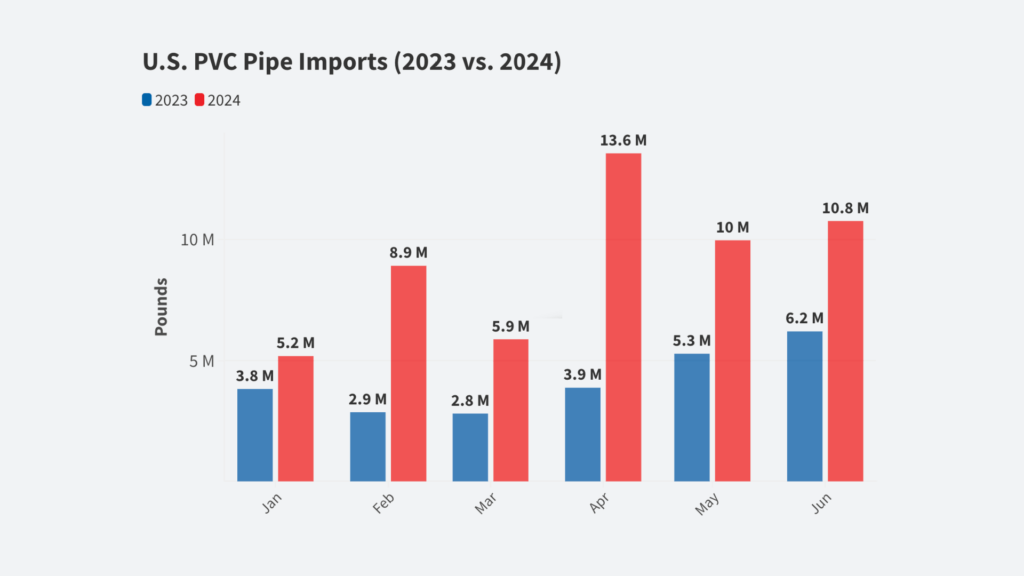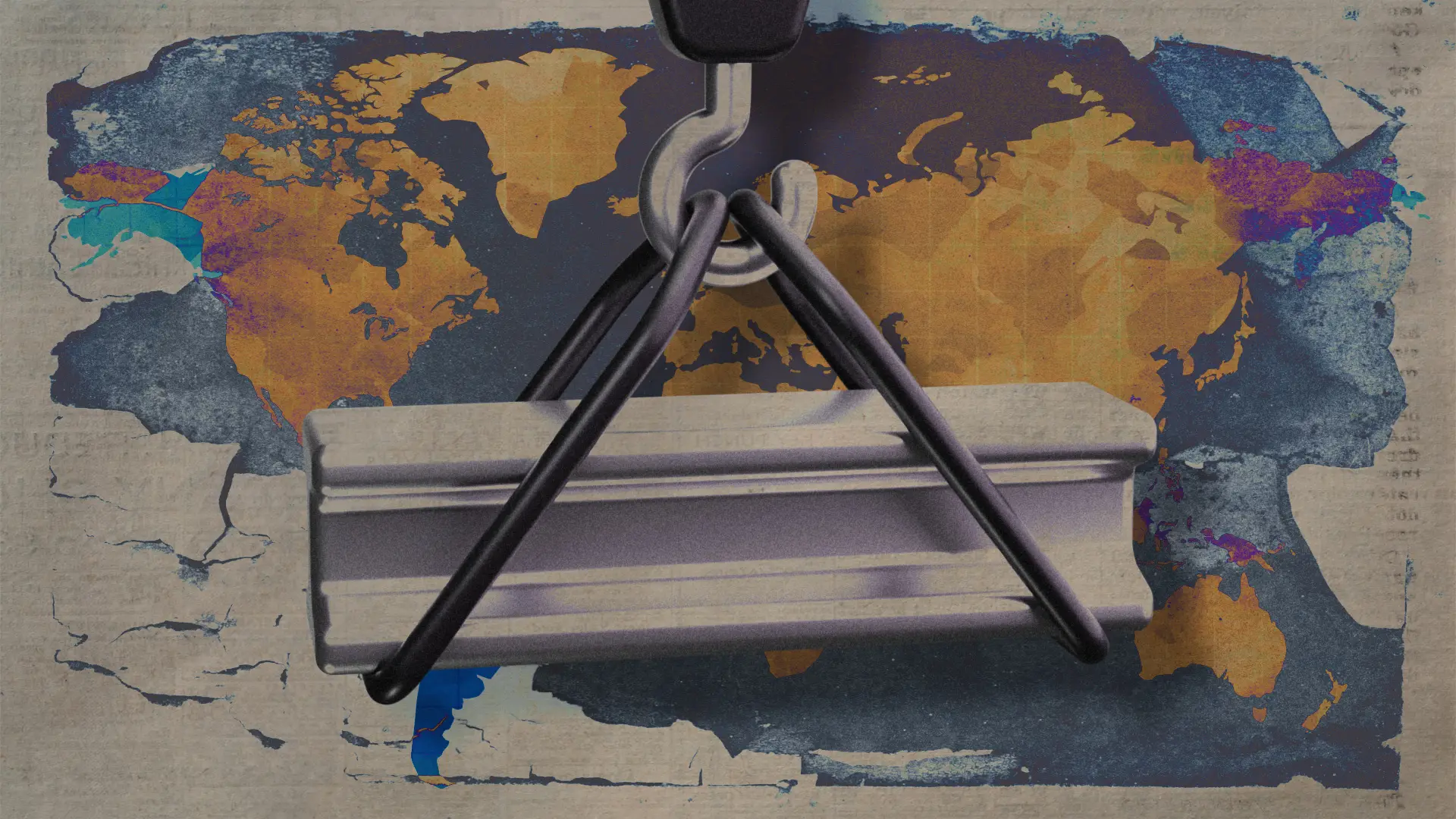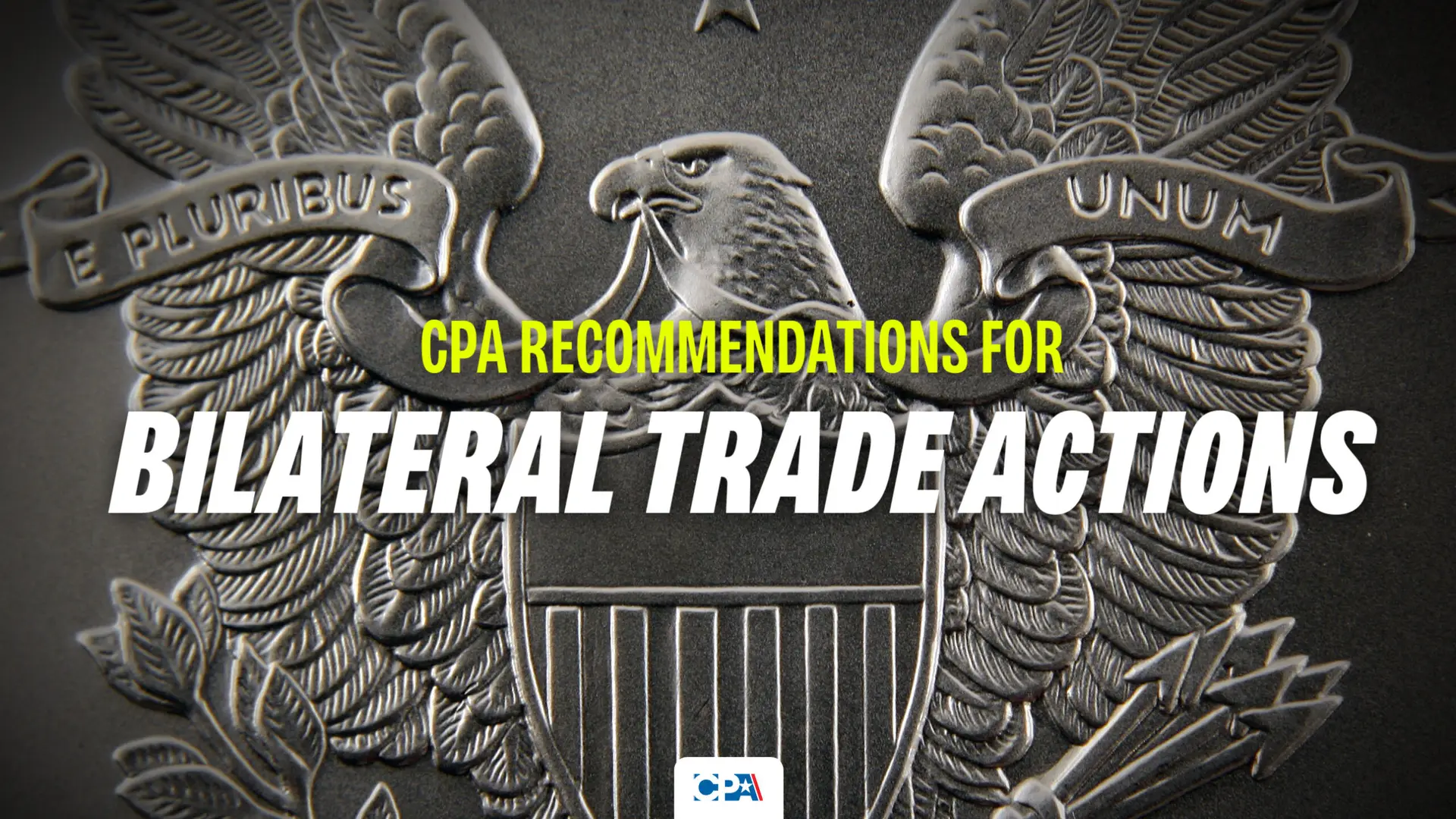KEY POINTS
- PVC pipe is critical for U.S. infrastructure, especially as electrical conduit in energy, data centers, and other high-tech sectors.
- PVC pipe imports are surging with 2024 import levels over twice as high as 2023 levels.
- Most imports are coming from Colombia, the Dominican Republic, and China, totaling 66% of all imports in 2024.
- Import surge harming U.S. producers and causing job losses, with over 6,000 plastic manufacturing jobs lost since last year.
- BABA Act loopholes are severely weakening the Buy American requirements and allowing a growing reliance on imports.
- The lack of specific HTS lines for PVC conduit stands as a major barrier to the U.S.’s ability to track and respond to trade issues in the industry.
U.S. Plastic Pipe Imports Surging in 2024
PVC pipe is a core component to U.S. electrical infrastructure. PVC conduit protecting and guiding electrical cables is vital for economic growth and technological advancement, as it is used extensively in expanding and upgrading the country’s electrical infrastructure across many sectors. However, this essential domestic industry is under severe threat.
The U.S. plastic pipe industry is currently facing an unprecedented surge in imports, which is heavily impacting domestic producers and the workers they support. As shown in Figure 1, U.S. plastic pipe imports have increased markedly from 2015 to 2024. In 2015, imports stood at a modest 284 thousand metric tons per year. However, by 2022, imports exploded to an unprecedented 568 thousand metric tons, with 2024 imports on pace to surpass that level and reach an all-time high.
Figure 1:
One of the most affected products within the overall plastic pipe import surge is PVC pipe. PVC (Polyvinyl Chloride) pipe plays a crucial role in the infrastructure of the United States, supporting essential sectors such as construction, water supply, and telecommunications.
The PVC pipe import surge continues to flood into the U.S. market at increasingly higher rates. As shown in Figure 2, 2024 PVC pipe import levels have risen far above 2023 levels. Total U.S. PVC pipe imports in the first half of 2024 are more than double the imports from the same period in 2023. This reflects an exponential and unsustainable flood of imports that will cause severe harm to the domestic U.S. industry if left unchecked.
Figure 2:
Colombia, Dominican Republic, and China Dominate Imports
The PVC pipe import surge stems largely from just a few major producers. Colombia is by far the largest import source, with 21.4 million pounds of imports in the first half of 2024. The next largest U.S. import sources are the Dominican Republic (at 7.7 million pounds) and China (at 6.8 million pounds). As shown in Figure 3, these three countries combined make up 66% of total U.S. PVC pipe imports in 2024 thus far.
Figure 3:
The concentration of the import surge in only a few select countries may imply a deliberate export strategy aimed to capitalize on the U.S. PVC pipe market and undermine domestic U.S. producers.
Lack of and Need for Specific Trade Data
A major issue standing in the way of the United States’ ability to track imports and encourage domestic production capacity for PVC conduit is the lack of specific government data. Currently, there are no specific designated HTS tariff number lines for plastic conduit pipe. These products are currently imported under broader plastic pipe HTS lines. Therefore, this critical material for U.S. infrastructure cannot be distinguished from other kinds of plastic pipe within the U.S. government trade data.
Trade data on PVC conduit must either be accounted for among many other plastic pipe types within government data (as shown in Figure 1), or isolated using private data platforms such as Panjiva (as shown in Figures 2 and 3).
This presents many problems with the United States’ policymaking ability to understand and address domestic production issues for this critical material which is essential for high-tech industries. Without specific HTS lines for PVC and HDPE plastic conduit, policymakers will not be able to fully understand the international economic position of the industry and respond to challenges and opportunities abroad. Policymakers also will not have the specific trade data needed to track import levels flooding and harming domestic production using government data, and also will not have the tools needed to address the import surge and protect U.S. jobs through targeting specific HTS lines with tariffs or quotas.
Import Surge Harming Domestic Industry
The influx of imported PVC pipes has had a pronounced impact on the domestic industry and U.S. economic security. This import flood has already begun to threaten the domestic U.S. market share and U.S. plastics manufacturing employment. As shown in Figure 4, the total U.S. plastic product manufacturing employment has steadily lost jobs over the past year as imports continue to rise. From just February to May 2024, the industry lost 1,400 jobs. Since June 2023, the industry has lost 6,300 jobs.
Figure 4: U.S. Plastic Product Manufacturing Employment
Jun-23 | Feb-24 | Mar-24 | Apr-24 | May-24 | |
Employment | 460,100 | 455,200 | 454,500 | 454,800 | 453,800 |
Source: U.S. Bureau of Labor Statistics
If the import surge is left unchecked, this level of employment loss will only be the tip of the iceberg. The import surge has likely already halted new investments and hiring in the industry, which won’t resume until the situation is addressed. We also have not yet seen the inevitable major plant closures that major import surges cause, but it may only be a matter of time given the accelerating flood of imports. If this issue continues, it will weaken long-term investment in local economies throughout the United States that rely on plastics manufacturing, bringing down employment, reducing the funds needed to innovate in the industry, and creating negative ripple effects that extend far beyond the PVC pipe industry. Based on current employment multiplier effect estimates, the downstream jobs affected by the 6,300 plastics manufacturing jobs lost over the past year total nearly 47,000. These jobs include service jobs and public sector jobs that were supported by consumer spending and taxes from manufacturing jobs in communities across the United States.
PVC Pipe Critical for U.S. Infrastructure
In addition to the employment effects, PVC pipe is also an indispensable component of U.S. infrastructure, playing a crucial role across various sectors due to its durability, cost-effectiveness, and versatility. Unlike metal pipes, PVC does not rust or corrode and is also extremely resistant to chemical deterioration, ensuring a longer lifespan and reducing maintenance costs. PVC is also easier to install and cheaper compared to many other conduit materials. Plastic pipe installation is about 30% faster compared to other materials used for piping.[1] This makes PVC and HDPE essential for quick and efficient deployment of new electrical infrastructure as well as for updating and replacing old infrastructure.
One of the key applications of PVC pipes is as conduits for high-tech industries, which are vital for the nation’s economic growth and technological advancement, especially as the United States seeks to invest and update critical high-tech infrastructure. High-tech industries, including telecommunications, data centers, hospital systems, transportation, energy sectors, and more, rely heavily on PVC conduits for protecting and routing electrical and data cables.
PVC is also used extensively in construction for plumbing and water pipes, wastewater, air ventilation, and more. PVC is by far the most widely used material for piping, accounting for 66% of water distribution piping and 75% of sanitary sewer piping.[2] HDPE piping is also used extensively in water and sewage systems, but also has a variety of other key infrastructure uses due to its durability, bendability, as well as chemical and extreme temperature resistance. PVC and HDPE plastic pipes ensure a reliable and safe supply of drinking water to communities across the country. In addition to water systems, HDPE pipe is also used for gas pipes, irrigation, and high-pressure pipelines.
The advancement of high-tech industries is crucial for maintaining the U.S.’s competitive edge in the global economy. Innovations in telecommunications, data processing, and renewable energy drive economic growth, create high-paying jobs, and improve the quality of life for citizens. PVC conduit is the essential backbone supporting these industries, reliably and efficiently protecting the underlying infrastructure. However, this key element, and consequently the United States’ economic security, is undermined when our capacity to produce PVC conduit is hindered.
[1] “Increasing Popularity of PVC Electrical Pipe,” n.d. https://www.cantexinc.com/news/post/why-has-pvc-electrical-pipe-become-increasingly-popular.
[2] “Vinyl in Design,” n.d. https://web.archive.org/web/20070822041842/http://vinylbydesign.com/site/page.asp?CID=14&DID=15.
Imports Undermining Build America, Buy America Act (BABA)
In response to these challenges, there has been a growing call for increased infrastructure spending to support American-made products. The Biden administration’s infrastructure plan, which includes significant investments in transportation, water systems, and broadband, presents a unique opportunity to bolster the domestic PVC pipe industry. However, within this investment, it is essential that government funds prioritize American-made products. This will stimulate domestic production, create jobs, and reduce the reliance on imports, especially from countries considered geopolitical adversaries such as China. The 2021 Build America, Buy America Act (BABA) seeks to do exactly this, but its effectiveness is also being severely undermined.
The Build America, Buy America Act (BABA), enacted in 2021, aims to boost the domestic U.S. economy by prioritizing American-made products in federal infrastructure projects. The essential element of BABA is that Federal funds for infrastructure projects must have a preference for American-made products. This includes all iron, steel, manufactured products, and construction materials (which include PVC pipe) used in covered infrastructure projects. To qualify as American-made the end-product must be produced in the United States, and most components must also be American-made.
The premise of this requirement is strong in supporting U.S. industry. However, the waivers included in the act greatly diminish its effectiveness, especially given the surging imports. The BABA Act includes waivers that carve out exceptions in a variety of scenarios that the import surge is exacerbating. These waivers are granted when required materials are not produced in the United States in sufficient and reasonably available quantities or when the use of American-made products would increase the cost of the overall project by more than 25%. Especially in the face of the current import surge, these waivers severely weaken the BABA Act and greatly diminish the support given to U.S. producers and jobs.
PVC pipe import levels are currently more than double the level of last year. Furthermore, imports are undercutting domestically produced PVC pipe on price by a wide margin. For example, average prices for plastic pipe imports are far below U.S.-made plastic pipe. As shown in Figure 5, the average price per kilogram of plastic pipe imports in 2024 is $6.46. The average price for plastic price coming from the United States as exports is over twice as much at $15.41 per kilogram. This price difference is more than enough to cross the 25% price difference threshold for a BABA Act waiver.
Figure 5: U.S. Plastic Pipe Import/Export Prices (HTS 3917): Jan-May 2024
Imports | Exports | |
Volume (KG) | 237,949,472 | 112,289,110 |
Value (USD) | $1,537,472,989 | $1,730,077,730 |
Price Per KG | $6.46 | $15.41 |
Source: U.S. Census
Furthermore, the surge of imports and the consistent undercutting of prices put great strain on domestic producers that will cause layoffs, closures, and diminished investment. This will also lead to a weakened capacity to produce PVC pipe domestically, further allowing imports to qualify for BABA Act waivers.
The U.S. needs to alter the BABA Act waivers to more fully support American-produced materials and also adopt a more comprehensive trade policy to further support these domestic producers critical to U.S. infrastructure and protect the industry from the flood of imports.
Conclusion
The U.S. plastic product manufacturing industry supports over 450,000 jobs across the country. The PVC pipe industry is not only essential for protecting and supporting our critical infrastructure, but it is also key to supporting high-quality U.S. jobs across the country, and all the secondary jobs that flow from the sector.
However, surging import levels and import prices far below those for domestically produced materials pose a great threat to the industry. Already, over 6,000 jobs have been lost in the U.S. plastic product manufacturing industry and import levels have only continued to rise.
Without comprehensive trade action and specific HTS lines covering PVC and HDPE conduit, the import surge will snowball and further diminish U.S. production, plastics employment, and domestic investment. All this undermines the United States’ ability to protect our critical infrastructure and support employment across the country. The U.S. government must take action to address this issue before it causes even more widespread harm.












